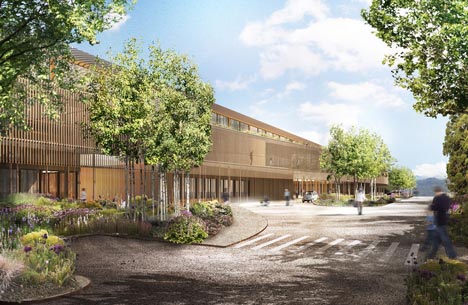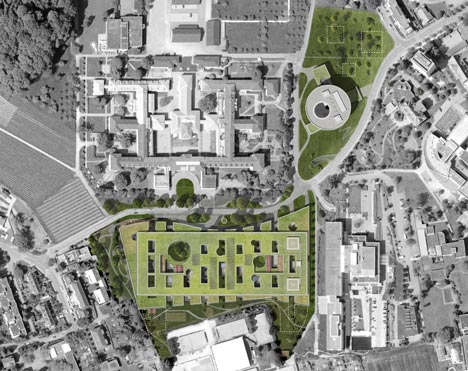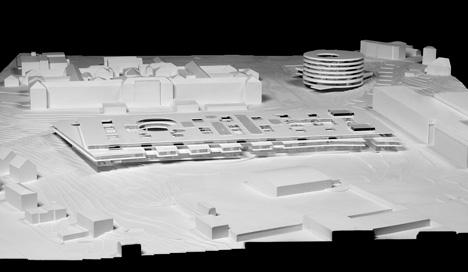Children’s Hospital Zurich by Herzog & de Meuron
Swiss architects Herzog & de Meuron have won a competition to design a children's hospital and a teaching/research centre in Zurich, Switzerland.

The three-storey hospital building will be constructed using locally milled timber and will accommodate a series of round and rectangular plant-filled courtyards for patients and their guests.

The teaching and research centre will be contained within a round six-story block and will also have a circular courtyard at its centre.

Herzog & de Meuron are the architects of this summer's Serpentine Gallery Pavilion in London. See images of the pavilion here, or watch our exclusive interview with Jacques Herzog about its design and conception.
See more projects by Herzog & de Meuron »
See all our stories about medical buildings »
Visualisations are by Bloomimages.
Here's some extra information from Herzog & de Meuron:
Children’s Hospital Zurich, Switzerland
For the realisation of a new building in the Lengg district of Zurich, Kinderspital Zürich called a two-phase planning selection procedure with pre-qualification in 2010. On 3 May 2012, at the recommendation of the jury, the foundation board of Kinderspital Zürich – Eleonorenstiftung unanimously declared the design by Herzog & de Meuron as the winning project. The project is planned for completion in 2018.
The design for the Children’s hospital envisions two complementary buildings of contrasting typology, programme and urban design, that are nevertheless geometrically related. The main hospital building serves the examination and treatment of children and adolescents, while the teaching and research centre serves scientific work and mediation.
The Children’s Hospital takes the form of a 3-storey building arranged around a series of courtyards like a small, introspective town. In-patients, out-patients and their relatives can move around as freely as possible between the different treatment areas. The 3-storey reflects the desire to create a child-friendly building, reminiscent in both scale and materiality of pavilion-style structures, and differs the usual hospital stereotype. Architecture and nature are interwoven here. The interior courtyards open up intermittently to the outside, allowing daylight to permeate the low, deep building.
Each of the three floors has a dedicated function, reflected in the layout of the rooms, and designed to provide maximum flexibility. Examination, treatment rooms and laboratories are located on the ground floor, as are the therapeutic facilities and the restaurant, while the doctors’ offices are situated on the first floor, and the wards on the top floor. Overlaying these three “ideal” geometries creates spatial variety and orientation. Wood is the predominant material of the facades and interiors, creating a more domestic atmosphere for children, their parents and hospital staff. The use of wood also echoes the rural surroundings of the Lengg district.
The Centre for Teaching and Research, a tall and round freestanding building, is positioned in an open space in the center of the health campus comprising several different clinics. It is an obviously public building in which everything revolves around scientific research and its dissemination. Six floors of research laboratories and offices are hovering above a kind of agora comprised of auditoria and seminar rooms. A central courtyard, also circular, follows the course of the sun.
Although the two building types are typologically different, they are architecturally related. Both feature an overlay of rectangular and circular geometries. In the children’s hospital, the circle is used to interfere the right-angled basic order and to mark specific areas of the building: points of orientation, sub-centres, meeting points, transitional areas. The round teaching and research centre is a meeting point in its own right, forming a sub-centre on the hospital campus. Within its circular shell, the rooms are arranged at right angles.
Herzog & de Meuron, 22 May 2012
“A hospital is a building type of the highest functional complexity, often designed by architects specialising in the field“, says senior partner Christine Binswanger, in charge of the project. “We are delighted that we have succeeded in fully grasping these functional complexities and that the jury has come to the decision that high quality architecture, economy and functionality need not be mutually exclusive.”
Jacques Herzog: “We chose to create a horizontal, finely structured building with a lot of natural light. The small scale and the material properties of this wooden building are factors that have already proved highly successful with our REHAB clinic in Basel. In the case of the children’s hospital, this seemed a particularly apt approach for the young patients and their parents.”
Christine Binswanger: “We also placed a lot of importance on flexibility – the working methods of doctors, nurses and hospital staff are bound to undergo changes in future. The building has to be able to accommodate those changes.”
Jacques Herzog “The fact that our first building in Zurich happens to be a children’s hospital is pure chance – but this makes it especially likeable.”
Project Team Partners: Jacques Herzog, Pierre de Meuron, Christine Binswanger (Partner in Charge)
Project Team: Mark Bähr (Project Manager), Jason Frantzen (Associate)
Alexandria Algard, Alexander Franz, Ondrej Janku, Christoph Jantos, Johannes Kohnle, Blanca Bravo Reyes, Raúl Torres Martin, Mika Zacharias
Client: Kinderspital Zürich – Eleonorenstiftung, Zurich
Competition: 1st Phase: March – May 2011 2nd Phase: October – February 2012:
Total floor area: 84.579 sqm
Structural engineering: ZPF Ingenieure AG, Basel
Landscaping: August Künzel, Münchenstein
General planning: Gruner AG, Basel